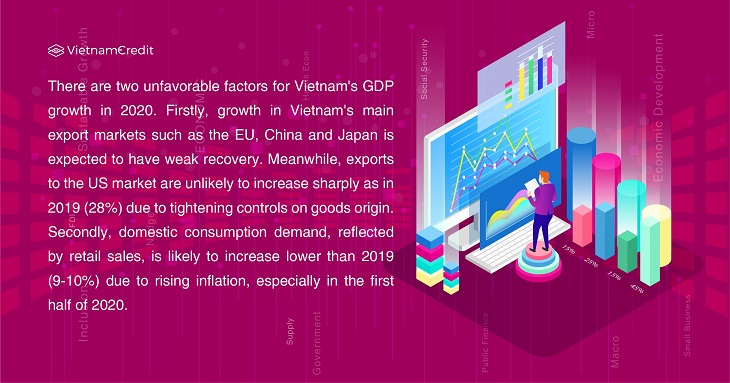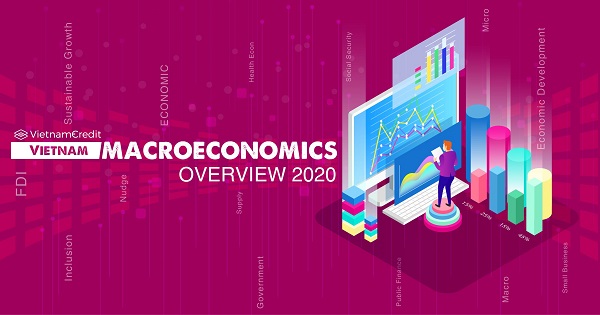Vietnam macroeconomics in 2020 is expected to face more challenges of growth and inflation control than in 2019.
Global macroeconomics
In terms of growth, after decelerating quite sharply in 2019, global economic growth is expected to recover slightly this year. More specifically, the world economy is likely to bottom out in the first two quarters of the year, and then regain momentum in the last two quarters. However, the growth recovery will take place unevenly among economies. Developed countries like the US, the European Union (EU), Japan, etc. are forecast to grow slowly while the opposite is true for emerging countries such as India, Indonesia, Brazil, etc.
Regarding financial conditions, in 2020, monetary policies of central banks around the world is likely to be similar to that at the end of 2019. Sharp and continuous cut of interest rates like in 2019 will not happen. In contrast, there is low probability that interest rates of central banks of countries will be raised. In the United States, the US Federal Reserve (Fed) said that it would keep interest rates at 1.5-1.75% in 2020. However, in case GDP growth of this country falls deeply below the potential level. (around 2%), the Fed may consider cutting interest rates further (because there is still room for Fed to cut interest rates).
The US-China trade war will remain intense. The trade conflict between the world's two largest economies, despite a tendency to cool down as the US and China say they have reached step-1 deal (expected to be signed by mid-January 2020), is still a is a big unknown and contains many uncertainties for global economic growth. In particular, in the context of the November 2020 presidential election, President Donald Trump's trade protectionism may soon return to win support from American citizens.
>> By 2030 Vietnam needs at least 100,000 digital technology businesses
Vietnam’s macroeconomics
Overall, GDP growth rate of 6.8-7% is achievable in 2020. Specifically, from perspective of supply, in the past years, the foreign-invested economic sector (FDI) have contributed about 20% to Vietnam's GDP, at the same time the growth of this sector has always been much higher than the general GDP growth. In 2018 and 2019, the growth of registered FDI in Vietnam (excluding capital contribution and share purchase transactions) tended to decrease, so it is likely that the growth of the FDI sector in the next few years will slow down.
On the demand side, there are two unfavorable factors for Vietnam's GDP growth in 2020. Firstly, growth in Vietnam's main export markets such as the EU, China and Japan is expected to have weak recovery. Meanwhile, exports to the US market are unlikely to increase sharply as in 2019 (28%) due to tightening controls on goods origin. Secondly, domestic consumption demand, reflected by retail sales, is likely to increase lower than 2019 (9-10%) due to rising inflation, especially in the first half of 2020.

In contrast, total social investment, which is the supporting factor for GDP growth in 2020, is expected to increase by about 13%, slightly higher than the increase in 2019. The main reason is that the revised Investment Law, which came into effect in early 2020, may help improve the rate of disbursed capital.
Regarding inflation, in 2020, the risk of monetary inflation and demand-pull inflation for Vietnam's economy is not considerable. Specifically, since 2014, the CPI has increased steadily below 5% thanks to stable credit growth and total means of payment (M2) remaining at 15-20% while n 2019, credit even increased by just over 13%. Therefore, the risk of monetary inflation is not worrisome.
Meanwhile, the increase in wage in 2020 is low (7.3%), which means the risk of inflation caused by demand pull will not be high as well. However, the biggest risk will come from cost-push inflation. The price of pork has increased sharply in the last three months, causing inflation over the same period last year (YoY) at the end of December to soar to 5.3%.
As forecasted by VietnamCredit, the YoY CPI will be particularly high (5-5.5%) in the first half of 2020 before cooling down towards the end of the year. Generally, CPI YoY by the end of 2020 will be at 3.2-3.6% while the average CPI for the whole year 2020 will fluctuate around 4%.
>>> VietnamCredit: All About Us
As for exchange rate, Vietnam has had an overall balance of payment surplus since 2016. Remarkably, the balance of payments surplus comes from both current account and capital balance. It is forecasted that Vietnam's overall balance of payments will continue to have a high surplus in 2020, mainly due to trade surplus, FDI inflows and stable remittances.
The pressure on the exchange rate in 2020 (if any) will mainly come from the continuing weakening trend of the yuan (China) and currencies of other emerging countries, making the competitiveness of Vietnamese exports decline. However, that Vietnam is listed by the US as "monetary manipulation" is a big problem, forcing the State Bank to be prudent in sharply depreciating the dong. The Vietnamese dongs is forecasted to depreciate by about 2% maximum in 2020.
>>> Why Is Vietnam The Exception In The Race Between Korea And Japan In The ASEAN Market?
VietnamCredit
























































